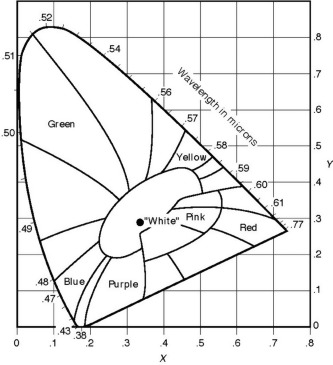It is very important to understand that white is not a spectral color, but a perceived color. Why?

White is not a spectral color. It's a perceived color.
The human eye has three kinds of color receptors, commonly called red, green, and blue.
There's no point on the spectrum that you could label as "white". White is a mixture of colors such that our eyes and brain can't distinguish which of red, green, or blue is the winner.
How much red, blue, and green does white light have?
There is no point in the spectrum that you could label as white. White is perceived as white color by our brain, made up of a combination of different colors, that out eyes' receptors sense. It is a commonly believed that there are three different types of cones for red, green and blue. In reality, these cones are sensing short (peaked at 445nm, we call it as blue), mid range (peaked at 535nm, we call it green), and long wavelength range (peaked at 575nm, we call it red) photons.
These receptors have a sensitivity range, that peaks at those wavelengths, but they are sensitive almost through the entire visible spectrum.

It is very important that there can be many different combinations of (different wavelength) photons that can give the perception of white. It is our brain that combines these signals coming from the receptors into a perception of white, and we cannot distinguish how this combination is reached, they will all produce the perception of white.
Yes, a photon by itself can be in a quantum superposition of different frequencies, which one might call "white".
No, such a photon probably can't be produced by a simple natural process.
No, such a photon would not look white, because the superposition collapses upon measurement, giving only one frequency. (Only one of your cone cells could possibly fire in response, assuming that any even fire at all.) However, a collection of many such photons would collectively look white.
Does a single white photon exist?
Now you are asking about a single photon, but a single photon cannot create the perception of white, because you need multiple photons, with certain different wavelengths to be able to create the perception of white in our brain. Please note, that however, a single photon is a QM entity, and it is possible for a single photon to be in a superposition of states so, that it could be interpreted as a combination of colors that could create white, but as the single photon interacts with the cones in the eye, its superposition collapses into an eigenstate with a single wavelength and thus cannot create the perception of white.




